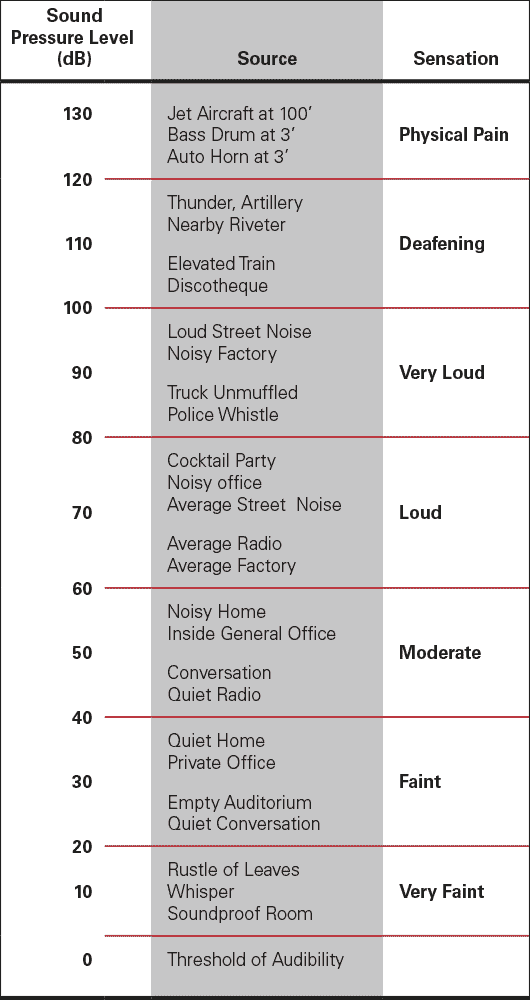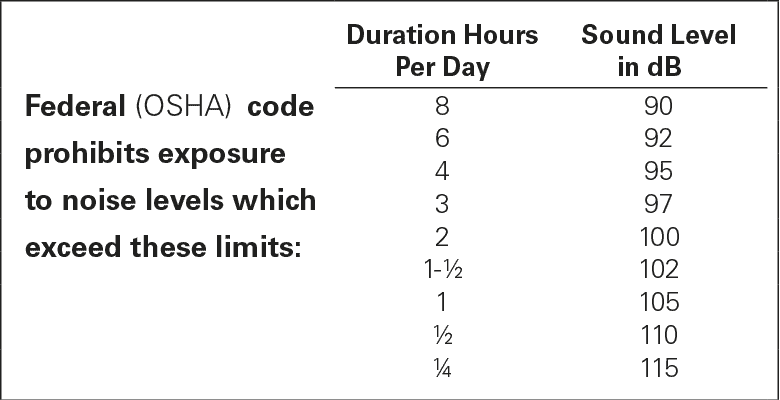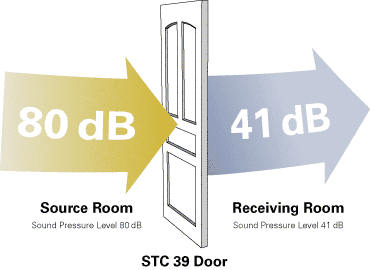Loud noise hurts everyone and it’s especially bad for business. Continued exposure impairs hearing and undermines emotional well-being, exposing employers to potential liabilities. Even at relatively low levels, unwanted noise can be a costly drain on employee morale and productivity.

Figure 1
The solutions to the endless list of noise problems and challenges fall into two basic categories. The science of sound-acoustics has yielded corresponding sound management techniques. Their application is determined by the nature of the particular noise problem:
- Absorption is the process of removing sound energy from within a room. Typically, that is accomplished using soft, porous materials exposed to soak up sound.
- Transmission is the movement of sound through a medium. Preventing the transfer of sound through door openings, specifically through clearances and gaps around a door, requires specialized products and techniques.
To define your specific problem, you need a basic understanding of how to quantify both your unwanted noise and the sound level that will be acceptable. The difference between those two values is the degree of sound control you need to achieve with your door opening.
Sound is vibrations in air moving in waves. The rate of sound pulsations measured in cycles per second is called frequency — also known as hertz (Hz).
Sound pressure levels are measured in decibels or dB. The scale of measurement used to simulate sound across the audible frequency range is denoted as dB. The human ear perceives changes in loudness caused by even small changes in those levels. Each 3dB increase doubles the sound reception and the annoyance or discomfort that goes with it.

Figure 2
When sound comes in contact with a barrier, such as a door, some of the energy from the vibrations transfers to the door. The resulting vibrations in the door itself then set the air in motion on the other side of the door, creating more sound vibrations.
The mass, damping and stiffness of the barrier determine its resistance to the passage of sound waves. The greater the mass, the less sound is transmitted through the barrier. Mass is especially important for blocking sound at lower frequencies. MDF, because of its weight and high density, is an excellent sound barrier and TruStile MDF doors provide superior sound barrier characteristics.
The stiffness of the barrier is also a factor in sound transmission. Sound control doors are generally made from very dense, stiff materials. These dense, stiff materials also work well at reflecting sound back to its source.

Figure 3
Sound Reduction Ratings:
Sound Transmission Loss (TL);
A door’s ability to reduce noise is called its sound transmission loss (TL) effectiveness. TL is a value given in decibels, which is determined by measuring sound pressure levels at a certain frequency in the source and receiving rooms. The calculation also factors in the area of the partition shared by the two rooms, and adjusts for the receiving room’s acoustic “liveness” (known as reverberation time). The adjusted difference between the two levels is the TL of the door. The higher the TL, the better the result.
Sound Transmission Class (STC):
TL measurements for a door are taken across a range of frequencies, which makes it difficult to compare the effectiveness of different doors. Sound transmission class (STC) ratings solve that problem by giving a single value to acoustical performance for a door. STC is determined by a weighted average of TL values taken over 16 frequencies, which are fitted to a curve in a method defined by the ASTM E413 Classification Standard for Rating Sound Insulation. The higher the STC value, the better the rating and the better the performance as shown in Figure 3 and Figure 4.
| STC | Performance | Description | |
|---|---|---|---|
| 50-60 | Excellent | Loud sounds heard faintly or not at all | |
| 40-50 | Very Good | Loud speech heard faintly | |
| TruStile Doors with Correct Gasketing | 35-40 | Good | Loud speech heard but hardly intelligible |
| 30-35 | Fair | Loud speech understood fairly well | |
| 25-30 | Poor | Normal speech understood easily and distinctly | |
| Typical Hollow Core Door | 20-25 | Very Poor | Low speech audible |
Figure 4
Acoustical Gasketing:
Naturally, the effectiveness of sound control doors varies with different combinations of materials. With so many variables, how can we determine how well a particular door will block sound? The most important thing to remember is that the door’s sound rating is only as good as the gasketing and perimeter seal that you incorporate into the opening.

Figure 5

Figure 6
Gasketing’s importance derives from a fundamental property of sound: Sound waves travel through any opening with very little loss. While the amount of air flowing through a gap increases in proportion with the size of the gap, the size of the gap in a sound barrier does not matter. A tiny hole transmits almost as much sound as a much larger gap.
Because of this phenomenon, any unsealed gaps and clearances in door assemblies effectively cancel out the noise reduction benefits of sound doors. For example, 1⁄8″ clearances around the edges reduce the effective rating of an STC-52 door to 21 — guaranteeing very poor acoustical performance and a great deal of discontent. The performance loss is especially serious at medium to high frequencies.
For acoustical gasketing to be effective at blocking sound, the seals around the head, jamb and sill must be complete, uninterrupted and air tight throughout the service life of the door. For uninterrupted contact, the gasketing must be installed all on the same side of the door and frame.
Ultimately, the quality of the acoustical gasketing is the biggest factor in overcoming any installation deficiencies and determining how close the actual sound performance of an assembly will come to the published rating of the door. See “Sound Doors” to learn more about the STC ratings that TruStile has achieved with its MDF Doors.